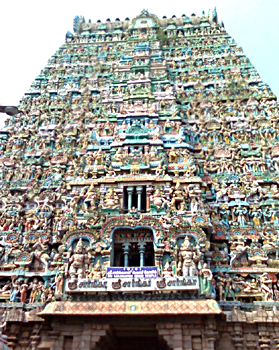 Sarnagapani Temple of Tamil Nadu has an old history. It has a number of legends associated with it regarding its formation. Maharshi Saunaka and others assembled on the bank of the river Saraswati to perform a sacrifice. They wanted to know who was the highest of the three Gods so that they could invoke Him to the sacrificial fire. To settle the disputed point regarding the superiority among the Gods, they requested Sage Bhrigu to meet the three Lords separately and pronounce a judgment.
Sarnagapani Temple of Tamil Nadu has an old history. It has a number of legends associated with it regarding its formation. Maharshi Saunaka and others assembled on the bank of the river Saraswati to perform a sacrifice. They wanted to know who was the highest of the three Gods so that they could invoke Him to the sacrificial fire. To settle the disputed point regarding the superiority among the Gods, they requested Sage Bhrigu to meet the three Lords separately and pronounce a judgment.
Bhrigu met Lord Brahma, Lord Vishnu and Maheswara individually and pronounced Vishnu to be the greatest because, in spite of his giving a kick to Vishnu, Vishnu did not lose his temper, but in turn showed every respect to him and washed his feet.
Bhrigu repented for his action and wanted to serve Lord Vishnu in two births. During his first rebirth he was known as Guha during the epic period of the Ramayana and in his next birth he was known as Sage Hema. He did penance and Vishnu gave him darsan. He wanted three boons viz., (i) Goddess Lakshmi (Vishnu`s consort) should be born as his daughter, (ii) Vishnu should become his son-in-law and (iii) he should get Sayujya Moksham i.e., liberation in physical form. Vishnu granted the boons and directed him to find Lakshmi on a thousand-petalled lotus where she had been praying for re-union with Vishnu after her departure in anger when Sage Bhrigu dealt a kick to him in her presence.
In this connection it may be appropriate to refer to the incident when Brahma and Lord Surya (Sun) prayed to Lord Vishnu long ago. Vishnu was pleased with their prayer and created three Vimanas viz., the Vaikuntha Vimana, Pranavakara Vimana and Vaideeka Vimana, and installed himself in each and distributed Vaikuntha Vimana to the residents Vaikuntha (Heaven), Pranavakara Vimana to Brahma and Vaideeka Vimana to Surya.
Surya passed on the Vaideeka Vimana to his son Vaivaswata Manu, who installed it on the banks of the river Sarayu and from him it passed on to Ikshwaku. Ikshwaku heard of the powers of liberation at sight of Pranavakara Vimana possessed by Brahma. He wanted to bring it to earth for the benefit of the human beings. As Vishnu wanted to appear on earth for some time, Brahma had to part with the Vimana and Ikshwaku got it. When the Vimana came to earth and was placed by the side of Vaideeka Vimana, both amalgamated into one. The amalgamated Vimana was subsequently brought to Srirangam.
As per as the birth of Goddess Lakshmi is considered it is said that it is said that Sage Hema went on pilgrimage and visited all sacred places and tanks. One day, he came across the thousand-petalled lotus with Goddess Lakshmi in it in the Hema Pushkarani or Golden Lotus tank, near the river Kaveri at Kumbakonam, where Brahma had already worshipped Vishnu in a previous birth. As the Goddess was found in the midst of lotus petals, she came to be known as Kamalavalalli. Sage Hema with great delight took the child to his hermitage and reared her up as his own daughter.
When the child grew up, she used to take morning ablutions along with the Sage in the Lotus tank. On the northern bank of the tank there used to be the heavenly Parijata Tree. Beneath it they used to engage in meditation. Later, the Vaideeka Vimana, which was amalgamated with Pranavakara Vimana was separated, and Lord Vishnu appeared in that Vimana before Sage Hema and his daughter Kamalavavalli on Makara Sankrama day in the month of Tai (January-February) in Rishabha Lagna.
To fulfil the grace shown to Saga Hema at Mount Meru to be his son-in-law, Vishnu took a physical form and Sage Hema performed the ceremonial rites of offering his daughter to Him in the same Lagna. So this place is known as Kalyana-puram (Kalyanam means marriage). As it was Devi Lakshmi who come to Kumbhakonam first and Mahavishnmu came afterwards to marry her, it has become the established tradition of the place to pay respects to the Devi first and to the Lord afterwards.
All devotees first offer worship to Kamalavalli and then to Lord Sarangapani. This place is also known as Devalokapattanam, ShivaVishnupuram, Mantradi Devasthanam, Sarangarajanpattanam, Kshetrasaram etc.
On account of some misunderstanding, Lord Sudarshan and Surya once started fighting; Surya was defeated and lost his brightness. To regain his lost lustre, Surya came to this place and performed penance. After many years of arduous penance, Surya pleased Lord Sarangapani and got back his original brightness. So this place is also known as Bhaskarapipuram.
Thus, it can be concluded saying that Sarangapani Temple has a long story associated with it and till today most of the customs that are undertaken in the temple is according to the legend.




















